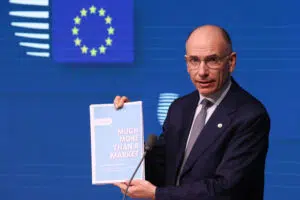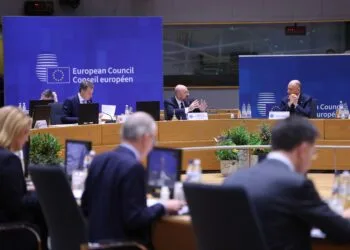Brussels – While the very short-term future of the European Union is upon us with European elections scheduled for June 6-9, the EU institutions are also focused on defining the foundational pillars of long-term competitiveness, from the Commission to the Council to the European Economic and Social Committee (EESC). “The EU cannot be just one big Single Market with rules and regulation reduced to zero; this kind of policy no longer holds up; on the contrary, it risks leading to a pulverization of the Single Market,” is the warning issued by the EESC opinion rapporteur on the long-term competitiveness strategy, Stefano Palmieri, in an interview with Eunews. A topic that is as important (as evidenced by the confrontation in Brussels over the reports of former Italian Prime Ministers Enrico Letta and Mario Draghi) as it is at risk of not being emphasized adequately by the political forces of the twenty-seven countries on the eve of the June vote: “Unfortunately I find this topic rather absent in the context of the debate on the upcoming European elections, even though it is fundamental to implement the factors necessary for competitiveness.”
What should be the pillars of the European Union’s long-term competitiveness Strategy?
“Competitiveness depends on several factors and actors—businesses, workers, social partners, central, regional and local governments providing key services—and is set on four areas of intervention: productivity growth, environmental sustainability, macroeconomic stability, and equity. In our opinion, we clearly explain that the guiding star should be Article 3 of the Treaty on European Union, according to which a highly competitive social market economy should aim at full employment, social progress, and a high level of environmental quality.
In this context, we believe some key actions emerge to ensure long-term competitiveness for the European Union. A budgetary framework that fosters public and private investment, an integrated European industrial strategy that is more than just the sum of the industrial policies of the 27 member countries, and a tangible and intangible, including social, infrastructure endowment for the digital revolution. Another element highlighted by our report is the Cohesion policy, which is the pillar on which to continue to base the European Union: it is fundamental for the functioning of the Internal Market. Delors had said it in the past, and Letta repeated it in his recent report.”
In what respects?
“It is important to have investments in quality public services, in transportation and energy networks that are adequate for current and future and EU challenges, but also in education and continuing training to have a workforce that is prepared for the changes taking place, in the health care system and long-term care for an ageing population. These are all crucial for worker safety, ensuring that productivity and, thus, competitiveness within the company is improved.
In addition, little has been said about regional competitiveness. The European Commission’s 2022 index shows a worrying map of the EU that has been greatly underestimated. Opposite a continental bloc where strong competitiveness emerges—driven by Germany, Belgium, Luxembourg, the Netherlands, Denmark, and Sweden—there is a bloc of countries which are struggling: from those in the Mediterranean, with some regions in particularly critical situations, going up the eastern ridge to Bulgaria, Romania, and Slovakia. When we talk about the competitiveness of the European Union, we need to dwell on the analysis of territorial competitiveness, which is why the Cohesion policy is of particular importance.”
What are the risks to the Single Market if an effective strategy for the future is not developed?
“Within the European Union, there is also a minimalist view of the Single Market, but this is not sustainable in several respects, starting with the social one. The Letta report also pointed out that the benefits of developing the Single Market must be shared among all citizens in all areas of the European Union; today, this is not the case. We need a quantum leap in economic and industrial policy, transport and energy networks. I think the next two years will be crucial to deciding the future of the EU, achieving a necessary deepening, and not just the enlargement of the Union. Fundamental choices are needed for the very survival of the EU.”

What is your assessment of Enrico Letta’s report on the future of the Single Market as a first step in setting a strategic agenda for competitiveness?
“Many aspects of our opinion are present in the Letta report, and we had a significant relationship with him. It is an excellent report, from which emerges the importance of industrial policy and Cohesion policy, and it is interesting the space it gives to social dialogue and sharing objectives with the productive forces to make possible changes in the structural arrangements of the economic and productive system of the EU. Extensive emphasis is given to quality jobs and social conditionality for EU funds regarding gaps in work safety or payment of social contributions. However, some critical elements that can be easily solved should be pointed out. For example, we agree in principle that reducing the restraining elements of competitiveness resulting from excessive administrative bureaucracy is necessary. However, this cannot and should not deteriorate the social rules of labour and environmental safety. They must still be maintained because they are not a cost, but a benefit to the community.”
On the financing side, the idea of the Capital Markets Union has been revived.
“As part of a single market, it is essential to have a banking union and a capital markets union. In his presentation, Letta repeated this several times and talked about the amount of savings in the EU that go mainly to the United States and then partly come back to the European Union. We need to move beyond this blockage for the growth of the European economic system. I was chairman of the Economic Section of the EESC for five years, and our position has always favoured completing the Banking Union and the capital market.”

From left: former Italian Prime Ministers Enrico Letta and Mario Draghi, respectively, responsible for the high-level report on the future of the Single Market and responsible for the report on the future of European competitiveness
What do you expect from Mario Draghi’s report on the future of European competitiveness?
“There is a lot of curiosity. Draghi was supposed to come to the EESC plenary when we presented this opinion, but he couldn’t. In any case, we sent him our opinion, and he listened to the social partners; for example, he attended the European Trade Union Confederation meeting, where there were some questions about the future relationship. There is a lot of anticipation, which has grown on the basis of the last two speeches—the one in Washington and the one in La Hulpe—which were particularly groundbreaking. If the report’s content starts from there, it will be very interesting. I hope it will be complementary to the Letta report and will dictate the agenda of the new Commission and the new Parliament, hoping that we will continue on the path traced by the founding fathers: that it will be a Union and not just a sum of states, without either national or European sovereignty.”
English version by the Translation Service of Withub








